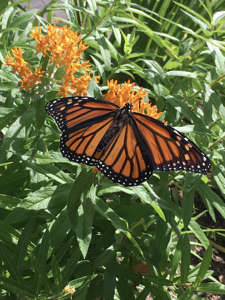Milkweed
Amplify its Benefits for Monarchs and Pollinators
Michele MacKinnon
It’s common knowledge in garden circles that milkweed attracts monarch butterflies. Simple changes in milkweed planting methods amplify benefits for monarchs and a host of pollinators.
Adam Baker, a doctoral candidate at the University of Kentucky’s Department of Entomology, shared findings from his study of monarch waystations at UCONN’s Pollinator Conference on October 3, 2019, in Storrs, Connecticut. The findings are easy to apply in our state.
Adam Baker’s Monarch Garden Tips and Tricks
Newborn monarch caterpillars will only eat the leaves of milkweed. Younger leaves are preferred. Baker’s research showed milkweed is easier for monarchs to find when planted as individual clumps surrounded by mulch. When milkweed is placed around the edges of gardens, monarch visits doubled and tripled. Gardens with a north/south axis also enjoyed higher numbers of monarch visitors.


Photo: Left- Monarch visits Butterfly Weed (Asclepias Tubersosa) Right- Monarch visits a zinnia
Photo credit: Michele MacKinnon
Milkweed Varieties Matter
Baker’s research proved interesting in terms of using a variety of milkweeds. Butterflies preferred Swamp Milkweed (Asclepias incarnata) and Common Milkweed (Asclepias syriaca). Contrary to its name, butterfly milkweed (Asclepias tuberosa) attracted numerous bee species. Basically, more milkweed varieties benefit more pollinator species. Taller, broad-leaved milkweed varieties saw more visits and had higher numbers of butterfly eggs and larva.
Native Connecticut milkweeds
Among the eight milkweed species Baker studied, three are Connecticut natives: Common (A. syriaca), Swamp (A. incarnata), and Butterfly (A. tuberosa.) Check the Protect Our Pollinators website for more information on these and other plants that support pollinators and for details on where to purchase them. Native plants are preferred food sources for native insects. If you can’t find native milkweeds, A. incarnata 'Ice Ballet’ and Whorled milkweed (A. verticillata) will still provide value. Common milkweed is better suited to larger, wilder settings, whereas the others mentioned work well in smaller, urban gardens. Milkweed can be grown from seed, ideally seed from mature plants in a nearby location. Area garden clubs or library seed clubs may be good sources for local seeds.
Plants for Monarch Migration
Gardeners and conservationists aren’t limited to milkweed alone. We can all do our part to aid the monarch fall migration by adding the autumn blooming Mexican Sunflowers (a.k.a. Tithonia / Torch flower), zinnias, native asters and goldenrods to our gardens. Goldenrod and asters may already grace the edges of your property, and here’s another reminder of their importance. Zinnias and Mexican Sunflowers are easily grown from seeds sold by a number of seed companies.
Two notes of caution
Butterfly houses, tiny replicas of wooden bird houses with narrow slits for insect access, are havens for European wasps that feed butterfly caterpillars to their young. Also, avoid planting Tropical milkweed (A. curassavica,) a tri-color variety that blooms so late it may cause monarchs to delay their migration and is a host for OE, a deadly parasite of monarchs.
To learn more about monarchs and other pollinators, visit these sites:
Milkweed Chart and Garden Tips and Tricks by Adam Baker with credit to his advisor Dr. Daniel A. Potter
Journey North - Tracking Migration and Seasons
Michele MacKinnon is a Sierra Club member, UCONN-Certified Advanced Master Gardener, garden educator, and speaker. Contact Michele MacKinnon for more information.
